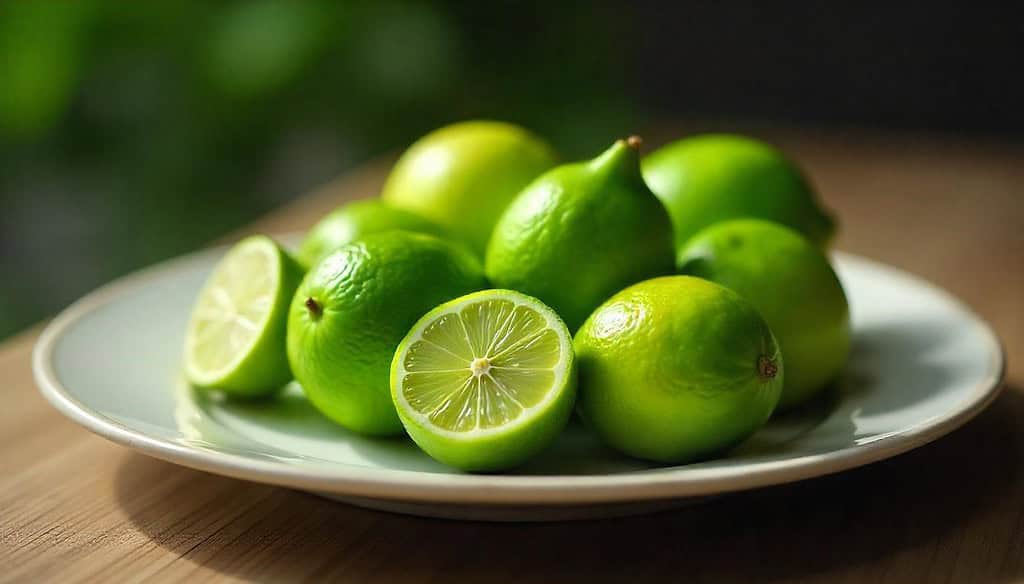Table of Contents
Limes: A ‘Sour’ Blessing

Lime, scientifically known as ‘Citrus aurantiifolia‘ and belonging to the Rutaceae family is one of the most significant citrus fruits worldwide and a blessing of nature. Renowned for its sour flavor and versatility, it holds a prominent place in both culinary and medicinal applications. Originating from tropical and subtropical regions, this citrus fruit has become an essential ingredient in various cuisines and industries across the globe.
There are several notable varieties of this fruit, each with its unique characteristics. The Persian variety, often referred to as Tahiti lime, is larger and has a milder flavor, making it popular for commercial use. The key lime, smaller and more acidic, is famous for its use in desserts such as key lime pie. The Kaffir variety, recognized for its aromatic leaves, is extensively used in Southeast Asian dishes for its strong fragrance and tangy juice.
The species that produces this fruit is a diminutive, evergreen tree or shrub, generally reaching heights between 4 and 10 feet. Its leaves are glossy, dark green, and lanceolate in shape, and release a notable citrus scent when crushed. The flowers of the plant are small, white, and fragrant, frequently appearing in clusters. The fruit is either spherical or oval, featuring a smooth rind that transitions from green to yellowish-green upon ripening, and its interior is juicy, containing a tangy, aromatic juice.
Consumption of this citrus marvel spans a wide spectrum. It is often used as a flavor enhancer in savory dishes, desserts, and beverages. Beyond its culinary appeal, the fruit’s juice, zest, and essential oils are key ingredients in marinades, sauces, and refreshing drinks. Its unique tang makes it a beloved addition to recipes and a vital part of global food culture. This versatile fruit truly embodies the essence of refreshment and vitality.
8 Amazing Lime Tales

1. Ancient Origins
The story of lime begins in the verdant, tropical landscapes of Southeast Asia, where it is believed to have first been cultivated. As a member of the citrus family, this citrus fruit shares a lineage with other fruits like oranges and lemons, but it possesses a distinct character defined by its tart flavor and bright green hue. Ancient civilizations valued it not only as a culinary delight but also for its practical uses in traditional medicine. Its sour juice, rich in vitamin C, was often utilized in remedies to treat various ailments, including digestive issues and skin irritations.
Though the exact timeline of lime domestication remains elusive, it is evident that the fruit was deeply integrated into the diets and lifestyles of early societies. Cultivation of this citrus fruit likely spread across Southeast Asia due to its adaptability to tropical climates, allowing it to thrive in diverse environments. Historical accounts suggest that the fruit was particularly popular in regions where its juice complemented rich, spicy dishes, enhancing their flavors while providing a refreshing counterbalance.
Lime’s ancient origins also intersect with mythology and spirituality. In some cultures, the fruit was believed to have protective properties and used in rituals to ward off evil spirits or cleanse spaces. These beliefs reflect the profound connection between this fruit and human culture, a bond that has only grown stronger over centuries.
This early chapter in Lime’s journey laid the foundation for its eventual global spread. Its resilience, versatility, and distinctive taste made it a prized fruit among traders and explorers, ensuring its journey beyond the borders of its native lands. Its humble beginnings in ancient groves mark the start of a remarkable journey that continues to shape its place in modern life.
2. Trade and Global Spread
Lime’s evolution from a local delicacy to an internationally recognized commodity exemplifies its versatility and lasting charm. The fruit embarked on its journey through ancient trade networks, transported by merchants who acknowledged its significance as both a culinary component and a medicinal asset. Historical records indicate that Arab traders were among the pioneers in bringing this fruit to the Middle East and North Africa, where the fruit swiftly became a vital element of regional cuisines and cultural practices.
The Mediterranean region was another significant milestone in Lime’s expansion. Introduced through trade and conquest, this citrus fruit found a receptive audience in Southern Europe. The tangy flavor and versatility of these citrus fruits made them a staple in Mediterranean cooking, where they were used in everything from marinades to refreshing beverages.
During the Age of Exploration, limes gained even greater prominence. European sailors discovered the fruit’s ability to prevent scurvy, a potentially fatal disease caused by vitamin C deficiency. They became a vital part of naval provisions, earning their place as a life-saving fruit during long sea voyages. This practical application led to the widespread cultivation of this fruit in colonial territories, particularly in the Americas.
In the New World, limes thrived in tropical climates, becoming an essential crop in regions such as the Caribbean and Central America. Over time, lime plantations expanded to meet the growing demand for the fruit in both local and international markets. Today, countries like Mexico, India, and Brazil are among the leading producers of this fruit, supplying this citrus marvel to kitchens and industries worldwide.
The global spread of limes illustrates how a humble fruit can transcend borders, adapting to new environments and cultures while maintaining its unique identity. Its journey across continents highlights the interconnectedness of human history and the natural world.
3. Cultural Symbolism
Limes hold a special place in the cultural traditions of many societies, often representing themes of vitality, protection, and prosperity. In Southeast Asia, where lime has its roots, the fruit is deeply embedded in rituals and ceremonies. It is commonly used to cleanse and purify spaces, reflecting its symbolic association with renewal and positivity. The sharp scent and vibrant color of lime are thought to dispel negativity, making it a favored element in spiritual practices.
In the Middle East, limes carry connotations of hospitality and generosity. Serving lime-infused drinks or dishes to guests is a gesture of warmth and welcome, a practice that continues to this day. Similarly, in Caribbean cultures, this citrus fruit is often used in rituals to ward off malevolent forces, reflecting its perceived protective qualities. These traditions underscore the fruit’s significance beyond its physical properties, highlighting its role in human expression and belief systems.
Art and literature have also celebrated lime’s symbolic value. In some cultures, the fruit is depicted as a representation of life’s zest and resilience. Its sourness, balanced by its refreshing qualities, serves as a metaphor for overcoming challenges and finding joy. Culinary traditions, too, emphasize its cultural importance. It is a staple in festive dishes and drinks, symbolizing abundance and celebration. Whether squeezed over a dish to enhance its flavor or served as a garnish in a vibrant cocktail, this citrus fruit adds a touch of vibrancy to culinary experiences.
The cultural symbolism of limes is a testament to their enduring relevance. Across continents and generations, this citrus fruit has remained a source of inspiration, embodying themes that resonate deeply with human experiences.
4. Medicinal Uses
The medicinal properties of lime have been recognized and utilized for centuries, earning it a revered place in traditional healing practices. Ancient herbalists and healers often turned to lime for its health-boosting qualities, using its juice and peel in remedies for a variety of ailments. Rich in vitamin C and antioxidants, limes were particularly valued for their ability to strengthen the immune system and prevent illnesses.
One of the most notable historical uses of lime was in combating scurvy, a disease caused by vitamin C deficiency. During the 18th and 19th centuries, British sailors were required to consume its juice as part of their daily rations, leading to the nickname “limeys.” This practice not only saved countless lives but also highlighted the fruit’s significance in medical history.
Beyond scurvy prevention, limes have been used to treat digestive issues, fevers, and skin conditions. The acidity of the juice aids in breaking down food, promoting better digestion, while its antimicrobial properties help combat infections. In traditional medicine systems such as Ayurveda and Traditional Chinese Medicine, this citrus fruit is considered cooling and detoxifying, used to balance the body’s energy and improve overall health.
Modern science continues to validate many of lime’s traditional uses. Studies have shown that the fruit’s compounds may have anti-inflammatory and anticancer properties, opening new avenues for its application in contemporary medicine. Additionally, lime’s essential oils are used in aromatherapy to alleviate stress and improve mood.
The medicinal benefits of lime extend far beyond its small size, making it a powerhouse of health and healing. Its long-standing reputation as a natural remedy underscores its importance in both historical and modern contexts.
5. Culinary Legacy
Lime’s impact on global cuisine is both profound and diverse, with its tangy flavor serving as a cornerstone in countless culinary traditions. The fruit’s versatility allows it to complement a wide range of dishes, from savory to sweet, enhancing its flavors and adding a refreshing twist.
In Southeast Asian cuisine, lime is a staple ingredient in many iconic dishes, such as Thai tom yum soup and Vietnamese pho. Its juice is often used to balance the heat of spicy dishes, providing a harmonious blend of flavors. In Indian cooking, pickles and chutneys, made from this citrus fruit, are cherished for their bold and zesty taste, while in Latin American cuisines, lime is an essential component of ceviche, a dish where the seafood is marinated in lime juice to create a vibrant and flavorful meal.
Beverages also owe much to lime’s unique qualities. From the classic mojito to limeade and margaritas, lime’s bright acidity adds a refreshing dimension to drinks. It is also a popular garnish, lending visual appeal and an aromatic zest to cocktails and mocktails alike.
Desserts, too, benefit from lime’s distinctive taste. Key lime pie, a beloved American dessert, is a testament to the fruit’s ability to shine in sweet creations. Similarly, lime zest and juice are often used in cakes, tarts, and sorbets, adding a lively citrus note that elevates the overall flavor.
The culinary legacy of this citrus fruit is a reflection of its adaptability and universal appeal. Its ability to enhance and transform dishes across cultures and cuisines makes it a cherished ingredient in kitchens worldwide.
6. Varieties of Lime
Limes come in several varieties, each with its own unique characteristics and culinary applications. The most common types are the Persian lime, the key lime, and the Kaffir lime, all of which have distinct features that set them apart.
The Persian lime, also known as the Tahiti lime, is the most widely available variety in grocery stores. It is larger and less acidic than other types, making it a versatile choice for both cooking and beverages. Its thick skin and longer shelf life make it ideal for commercial distribution, ensuring its presence in markets around the globe.
The key lime, by contrast, is smaller and has a more intense flavor. Known for its thin skin and high acidity, the key lime is a favorite in desserts such as the iconic key lime pie. It is also a popular choice for marinades and cocktails, where its bold taste can shine.
The Kaffir lime, native to Southeast Asia, is notable for its fragrant leaves as much as its fruit. The leaves are often used in Thai and Indonesian cuisines, imparting a distinct citrus aroma to soups, curries, and stir-fries. The fruit itself is knobbly and less juicy but has a strong, tangy flavor that is prized in culinary and medicinal uses.
Other lesser-known varieties, such as the Rangpur lime and desert lime, add to the diversity of this citrus family. Each type brings its own unique qualities to the table, showcasing the versatility and richness of limes.
7. Scientific and Industrial Applications
Lime’s utility extends far beyond the kitchen, with its chemical properties making it valuable in various scientific and industrial applications. One of its most notable uses is in the production of citric acid, a key ingredient in food preservation, cleaning products, and cosmetics. Lime juice and oil are also widely used in the fragrance industry, where their fresh, citrusy aroma is a popular choice for perfumes and air fresheners.
In the realm of science, lime’s acidic nature makes it a powerful agent for cleaning and sterilization. Its juice is often used as a natural disinfectant, capable of breaking down grease and killing bacteria. This property is particularly valuable in eco-friendly cleaning products, where lime serves as an effective and biodegradable alternative to synthetic chemicals.
Lime also plays a role in water treatment and agricultural practices. Its juice and peels are used in composting to enhance soil fertility, while lime-based solutions are employed to adjust pH levels in water and soil. In some industries, lime extracts are utilized in the production of biofuels, highlighting their potential in sustainable energy solutions.
The essential oils derived from lime are another area of interest, particularly in aromatherapy and pharmaceuticals. These oils are believed to have mood-enhancing and stress-relieving properties, making them a popular choice for wellness products.
The scientific and industrial applications of lime demonstrate its multifaceted value. From everyday household uses to advanced technologies, this citrus fruit continues to contribute to innovation and sustainability.
8. Environmental Importance
Lime cultivation plays a significant role in agriculture and the environment, offering benefits that extend beyond its fruit. The trees are hardy and adaptable, thriving in tropical and subtropical climates with relatively low water requirements. This resilience makes them a valuable crop in regions where water scarcity is a concern, contributing to sustainable farming practices.
In addition to their practicality, Lime trees are also important for biodiversity. Their blossoms attract pollinators such as bees and butterflies, supporting the health of ecosystems. The trees themselves provide habitat for various species, further enriching the environment.
Lime farming, when practiced sustainably, can help combat soil erosion and improve soil quality. The fruit’s peels and pulp are often used as natural compost, enriching the soil with nutrients and reducing agricultural waste. Moreover, its role in agroforestry systems highlights its potential in promoting ecological balance.
However, lime cultivation is not without challenges. The industry faces issues such as pests, diseases, and climate change, which threaten both yield and quality. Addressing these challenges requires a commitment to sustainable practices, including organic farming and integrated pest management.
The environmental importance of lime underscores its role as more than just a fruit. It is a vital component of agricultural systems and a contributor to ecological health, making its cultivation a meaningful endeavor for both farmers and the planet.
Limes: The Nutrient Powerhouse

Let me take you on a journey into the world of this tiny but mighty fruit. When you think of a burst of freshness, what comes to mind? For me, it’s the unmistakable zing of this citrus fruit. But beyond its vibrant flavor, did you know that this fruit is also packed with a treasure trove of vitamins, minerals, and antioxidants? Let’s dive into the hidden nutritional gems it offers.
One of the standout features of this fruit is its high vitamin C content. Just a single serving can provide more than half of the recommended daily intake. This vitamin, known for its immune-boosting properties, is vital in fighting off illness and protecting the skin from damage. But that’s not all—the fruit also contains a healthy dose of vitamin A, which helps with vision, skin health, and immune function.
Minerals like potassium and magnesium are abundant in this citrus fruit as well. Potassium helps balance fluid levels in your body and supports heart health, while magnesium plays a crucial role in muscle function and energy production. Alongside these, you’ll also find trace minerals like calcium and iron, which help maintain bone health and support red blood cell production.
As for antioxidants, this fruit doesn’t fall short either. Flavonoids, known for their ability to fight free radicals and reduce inflammation, are abundant in the fruit’s peel and juice. These antioxidants contribute to heart health, anti-aging, and overall wellness.
When you add this fruit to your daily routine, you’re not just enhancing your meals; you’re giving your body a powerful boost of essential nutrients. A simple slice or splash of this citrus wonder is all it takes to unlock a world of health benefits.
The Hidden Drawbacks of the Mighty Lime

But before you rush to grab the next Lime you see, let’s take a moment to think about the other side of the story. While this fruit is undoubtedly packed with nutrients, it’s not all sunshine and rainbows when it comes to its consumption.
For one, the fruit’s high acidity can be a problem for some. Have you ever experienced that uncomfortable burn in your throat after drinking lime juice? It’s a reality for many, especially those who suffer from acid reflux or sensitive stomachs. The sharp acidity can irritate the lining of the stomach, leading to discomfort or even ulcers if consumed in excess.
Then there’s the issue of the fruit’s juice, which, though refreshing, can be tough on your teeth. The citric acid in the juice can erode enamel over time, leading to increased sensitivity and a higher risk of cavities. It’s a reminder to always rinse your mouth after indulging in its tangy goodness.
Limes also come with their share of environmental concerns. While they thrive in tropical climates, their cultivation requires significant water resources and, in some cases, extensive pesticide use. These factors contribute to the ecological footprint of the fruit, making it less sustainable in certain regions.
So, while the fruit might seem like a perfect addition to your kitchen, remember that like everything else, moderation is key. It’s all about balancing the benefits with the potential drawbacks to truly appreciate this nutrient-packed fruit.
Disclaimers: *This article is only for informational purposes.
**Do not make your important decisions solely based on the information provided in this article. Do your own research.
***Consult a doctor or a medical professional in case of a medical emergency.
****Information in this article may vary or get updated in the future.
Read More Science and Space Articles
- 8 Weird Ways Grapefruit Can Interfere with Medications
- Our Universe: 10 Most Powerful Forces That Shaped Its Fate
- Pomelo in Culture: 8 Heartwarming Ritual Traditions
- 8 Culinary Uses of Oranges That I Highly Recommend
- 8 Astounding Ways Lemons Have Helped Elevate My Mood
- 8 Irresistible Ericaceae Fruits (Heath Family) to Savor and Enjoy
- 8 Incredible and Healthy Cucurbitaceae Fruits to Enjoy
- Top 8 Delicious Anacardiaceae Fruits You Must Try
- 8 Incredible Musaceae Fruits You Need to Try Right Now
- 8 Incredible Vitaceae Fruits: Nature’s Tasty Treasures
- 8 Incredible Rosaceae Fruits You Need to Discover
- Discover 8 Fruit Families That Enrich Our Daily Diets
- 8 Non-CO₂ Greenhouse Gasses That Are Worst Than CO₂
- 8 Ways Water Crisis is Worsened by Global Climate Change
- 8 Amazing Ways Brain Anatomy is Altered by New Learning
- 8 Disastrous Ways Deforestation Destroys Biodiversity
- 8 Worst Ways Global Climate Change Hurts The Impoverished
- Danger Of Environmental Damage: 8 Ways A Person Can Help
- Eradication Of Poverty: 8 Critical Ways Science Helps
- Mathematics: 8 Interesting Ways To Become Efficient At It
- STEM Fields: 8 Important Reasons Why You Must Learn Them
- Making Your Kid Efficient At STEM Subjects: 8 Important Steps
- Becoming A NASA Aspirant: 8 Important Steps You Must Follow
- Top 8 Important Wellness Habits That You Must Follow
- Top 5 Amazing Whole Grains That Are Healthier Than Rice
- Indian Space Program: 8 Incredible Achievements
- Discoveries by JWST: 10 Incredible Findings of The Telescope
- NASA’s MOXIE Creates O2: Big Step Towards Mars Colonization
- Top 5 Amazing Properties of Time That Defy Common Sense
- 10 Factors for Emergence of Intelligent Life in The Universe
- Space Science: 6 Vital Reasons Why We Should Invest in It
- Solar System: 10 Astonishing Uniqueness of our star system
- Top 6 Solar System Objects That Might Destroy Life On Earth
- Certain End of The Universe: 4 Forces of Nature to Watch Out For




